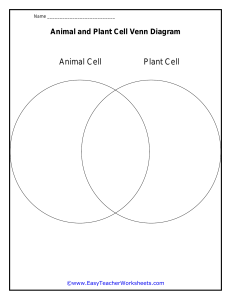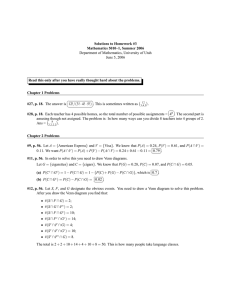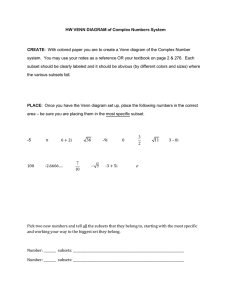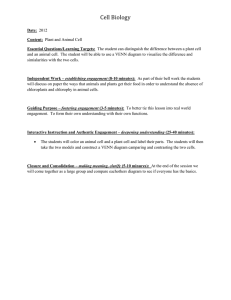Set Theory: Introduction to Sets, Operations, and Venn Diagrams
advertisement
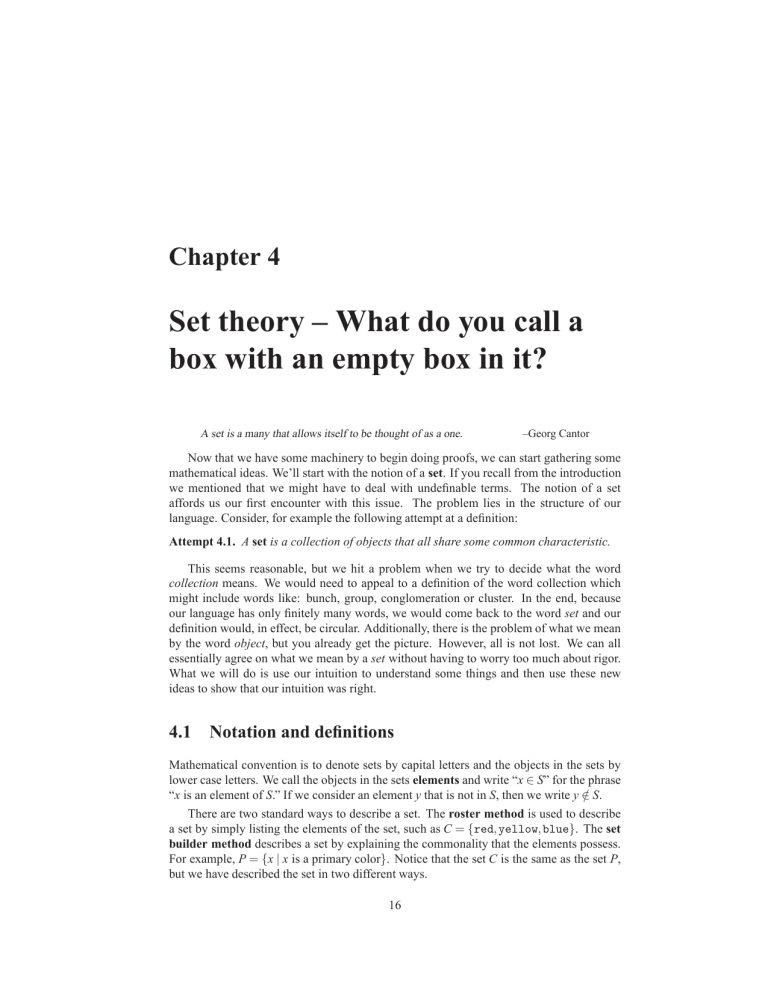
Chapter 4
Set theory – What do you call a
box with an empty box in it?
A set is a many that allows itself to be thought of as a one.
–Georg Cantor
Now that we have some machinery to begin doing proofs, we can start gathering some
mathematical ideas. We’ll start with the notion of a set. If you recall from the introduction
we mentioned that we might have to deal with undefinable terms. The notion of a set
affords us our first encounter with this issue. The problem lies in the structure of our
language. Consider, for example the following attempt at a definition:
Attempt 4.1. A set is a collection of objects that all share some common characteristic.
This seems reasonable, but we hit a problem when we try to decide what the word
collection means. We would need to appeal to a definition of the word collection which
might include words like: bunch, group, conglomeration or cluster. In the end, because
our language has only finitely many words, we would come back to the word set and our
definition would, in effect, be circular. Additionally, there is the problem of what we mean
by the word object, but you already get the picture. However, all is not lost. We can all
essentially agree on what we mean by a set without having to worry too much about rigor.
What we will do is use our intuition to understand some things and then use these new
ideas to show that our intuition was right.
4.1 Notation and definitions
Mathematical convention is to denote sets by capital letters and the objects in the sets by
lower case letters. We call the objects in the sets elements and write “x ∈ S” for the phrase
“x is an element of S.” If we consider an element y that is not in S, then we write y ∈
/ S.
There are two standard ways to describe a set. The roster method is used to describe
a set by simply listing the elements of the set, such as C = {red, yellow, blue}. The set
builder method describes a set by explaining the commonality that the elements possess.
For example, P = {x | x is a primary color}. Notice that the set C is the same as the set P,
but we have described the set in two different ways.
16
Set theory – What do you call a box with an empty box in it?
17
One thing we will need to be careful about is where our sets live. Given a set, or
collection of sets, we need to specify the context in which we’re considering it, or them.
That is, every set lives inside some universal set. For example, if we consider the set S
to contain the last year of the twentieth century during which the Boston Red Sox won the
world series, then S = {1918} and our universal set U could be the years between 1901 and
2000. That is U = {1901, 1902, . . .1999, 2000}. Of course there may be many others.
Example 4.2. Here are some examples of sets. For each set, choose two larger sets which
could be appropriate universal sets.
1. A = {odd prime numbers less than 10} (Can you rewrite this set in a different way?)
2. B = {x | x2 − 8x + 12 = 0} (Can you rewrite this set in a different way?)
3. C = {West Virginia, South Carolina, Ohio, Georgia}
4. D = {West Virginia, South Carolina, Ohio, Virginia}
Just like numbers, sets are mathematical objects. Hence there are operations we can
perform on sets to get new different sets. There are many operations we can perform on
sets, but we will deal mainly with three. These are the most common and will suffice for
most of our purposes. We’ll begin with the definition of equality.
Definition 4.3. If A and B are sets, then we say that A and B are equal, and write A = B,
precisely when A and B contain the same elements.
Definition 4.4. If A and B are sets, then we say that A is a subset of B, written A ⊆ B, if
every element of A is an element of B.
Definition 4.5. We let ∅ denote the set that contains no elements and call ∅ the empty
set.
Note: We can also write the empty set as {}, but not {∅}. (Why?)
Definition 4.6. If A and B are sets, then the union of A and B, written A ∪ B, is the set of
all elements that are in A or B.
Definition 4.7. If A and B are sets, then the intersection of A and B, written A ∩ B, is the
set of all elements that A and B have in common.
Definition 4.8. If A and B are sets and A ∩ B = ∅, then A and B are said to be disjoint.
Exercise 4.9. For the sets in Example 4.2 form the following unions and intersections.
Write the sets using set builder notation or the roster method.
1. A ∪ B
2. A ∩ B
3. C ∪ D
4. C ∩ D
5. A ∪ D
Definition 4.10. If A is a subset of a universal set U, then the complement of A, written
Ac is the set of all elements of U that are not in A.
Problem 4.11. If A ⊆ B, then Bc ⊆ Ac .
Definition 4.12. If A and B are sets, then the set difference of A and B, or A minus B,
written A \ B is the set of all elements of A that are not in B.
Problem 4.13. Let A and B be sets. Show that A \ B = A ∩ Bc .
Example 4.14. Let A = {1, 2, 3, 4, 5, 6, 7, 8, 9, 10}, B = {2, 4, 6, 8, 10}, C = {2, 3, 5, 7} and
D = {3, 5, 7, 9}. Define the following:
1. A \ C
2. B ∪C
3. C ∩ D
4. B ∪ D
Ron Taylor
Journal of Inquiry-Based Learning in Mathematics
Set theory – What do you call a box with an empty box in it?
18
4.2 Venn diagrams
We can sometimes represent the operations on sets graphically. If we have two sets, then
we can use the following Venn diagram to compute the set operations from the preceding
section. Notice that the two circles break the universal set into four distinct regions. There
are two regions that contain the elements in either A or B but not in both. (Regions 1 and
2.) The middle football shaped region (#3) contains the elements that are common to both
A and B and the region outside (#4) contains the elements of the universal set that are in
neither A nor B.
Figure 4.1. A Venn diagram for two sets A and B.
Exercise 4.15. Match the following sets with the regions of the Venn diagram above.
1. A ∩ B
2. A \ B
3. (A ∪ B)c
4. B \ A
We can extend this notion to Venn diagrams with three sets. This splits up the universal set
unto eight distinct pieces.
Figure 4.2. A Venn diagram for three sets A, B and C.
Exercise 4.16. Describe in words each of the eight regions in the three set Venn diagram.
Exercise 4.17. Use set notation to describe each of the regions in the three set Venn diagram.
Ron Taylor
Journal of Inquiry-Based Learning in Mathematics
Set theory – What do you call a box with an empty box in it?
19
Exercise 4.18. Draw a Venn diagram for each of the following sets.
1. (A ∪ B ∪C)c
2. (A ∩ B ∩C)c
Question 4.19. Can you find Venn diagrams for four or more sets?
4.3 Set operations
We can collect set operations that are analogous to the operations we had in Section 1
with regard to logical expressions. We can use Venn diagrams to get some intuition about
proving statements about sets, though these pictures do not suffice to make a proof. The
first four problems collect several facts about sets that should hopefully come as no surprise
even though they might be counterintuitive at first glance.
Problem 4.20 (The Transitive Property). If A ⊆ B and B ⊆ C, then A ⊆ C.
Problem 4.21. If A is a subset of the universal set U, then:
1. A ∩U = A
2. A ∪ ∅ = A
Problem 4.22. If A is a subset of the universal set U, then:
1. A ⊆ A
2. ∅ ⊆ A
Problem 4.23. If A is a subset of the universal set U, then:
1. A ∪ Ac = U
2. A ∩ Ac = ∅
The following axiom will provide us a convenient technique to use when attempting
to prove that two, possibly different looking, sets are the same set. It will come up often
during this section.
Axiom 4.24. Let A and B each be a set. Then A = B iff A ⊆ B and B ⊆ A.
The theorems that follow are set theory analogues to statements you know about logical
connectives. That they would hold for sets as well should be straightforward to see and their
proofs are similar to those in the logic section.
For the following four theorems, suppose A, B and C are subsets of a universal set U.
Problem 4.25 (The Associative Property). Prove the following statements:
1. A ∪ (B ∪C) = (A ∪ B) ∪C)
2. A ∩ (B ∩C) = (A ∩ B) ∩C)
Ron Taylor
Journal of Inquiry-Based Learning in Mathematics
Set theory – What do you call a box with an empty box in it?
20
Problem 4.26 (The Commutative Property). Prove the following statements:
1. A ∪ B = B ∪ A
2. A ∩ B = B ∩ A
Problem 4.27 (The Distributive Property I). Prove the following statements:
1. A ∩ (B ∪C) = (A ∩ B) ∪ (A ∩C)
2. A ∪ (B ∩C) = (A ∪ B) ∩ (A ∪C)
Problem 4.28 (The Distributive Property II). Prove the following statements:
1. (A ∩ B)c = Ac ∪ Bc
2. (A ∪ B)c = Ac ∩ Bc
In the following four problems, A, B and C are subsets of a universal set U.
Problem 4.29. A = (A \ B) ∪ (A ∩ B)
Problem 4.30. A \ (A \ B) = A ∩ B
Problem 4.31. A \ (B \ C) = (A \ B) ∪ (A ∩C)
Problem 4.32. (A \ B) ∪ (B \ A) = (A ∪ B) \ (A ∩ B)
4.4 Set products and power sets
We can use existing sets to create new sets in other ways besides combining them in the
context of an existing universal set like we did in the last section. Recall the Cartesian
plane you learned about in high school algebra. How did you think about this? Probably as
just the set of ordered pairs of real numbers. We can extend this idea to other pairs of sets.
We’ll start with the following definition:
Definition 4.33. If X and Y are sets, then the set product or cross product of X and Y ,
written X × Y , is defined as the set of all ordered pairs of the form (x, y) such that x ∈ X
and y ∈ Y . That is
X × Y = {(x, y) | x ∈ X, y ∈ Y }.
If X = Y , then we can write X × X as X 2 .
Note that this definition fits our intuitive understanding of an ordered pair, and this will
suffice for our purposes. However, when
n the full rigor
o of set theory is brought to bear, we
define the ordered pair (x, y) by the set {x}, {x, y} .
Exercise 4.34. Explain why the definition of ordered pair (x, y) from above captures the
idea of an ordered pair.
Example 4.35. Let S = {a, b, c} and T = {1, 2}. Then the set S × T is given by:
S × T = {(a, 1), (a, 2), (b, 1), (b, 2), (c, 1), (c, 2)}.
Ron Taylor
Journal of Inquiry-Based Learning in Mathematics
Set theory – What do you call a box with an empty box in it?
21
Exercise 4.36. For the sets A = {, △, } and B = {•, •, •} form the products A × A,
A × B, B × A and B × B. Is A × B = B × A? Why?
We will see this idea again when we start talking about functions and relations. It is
the foundation of how these concepts work and is the basis for many other structures in
algebra, analysis, topology and geometry.
Problem 4.37. Let A, B, C and D be sets. If A ⊆ B and C ⊆ D, then (A × C) ⊆ (B × D).
Problem 4.38. Let A, B and C be sets. Then (A ∪ B) × C = (A × B) ∪ (B × C).
Problem 4.39. Let A, B and C be sets. Then A × (B \ C) = (A × B) \ (A × C).
Problem 4.40. Let A, B, C and D be sets. Then (A \ B) × (C \ D) = (A × C) \ [(A × D) ∪
(B × C)].
Exercise 4.41. Given three sets A, B and C, how do you think the set A × B × C should be
defined? How would this set compare to the set A × (B × C)? (A × B) × C?
Exercise 4.42. Let A = {a, b, c}, B = {1, 2} and C = {red, blue, green}. How many elements should there be in the set A × B × C? Form the set A × B × C.
Exercise 4.43. Give a rigorous definition of an ordered triple (x, y, z).
Exercise 4.44. Suppose A, B and C are sets. Does (A × B) × C = A × (B × C)? Explain.
Now we move to the idea of a power set. This is another method of creating new sets
from old. We’ll start with a definition.
Definition 4.45. If P is a set, then the power set of S, written P(S), is the set of all subsets
of S. That is P(S) = {B | B ⊆ S}.
Example 4.46. Let S = {a, b, c}. Then
n
o
P(S) = ∅, {a}, {b}, {c}, {a, b}, {a, c}, {b, c}, {a, b, c} .
Exercise 4.47. If S is a set with n elements, then P(S) has 2n elements.
Problem 4.48. Prove that S = T if and only if P(S) = P(T ).
In the following three problems, let A and B be sets. Prove, or Disprove and Salvage if
possible:
Problem 4.49. P(A ∩ B) = P(A) ∩ P(B)
Problem 4.50. P(A ∪ B) = P(A) ∪ P(B)
Problem 4.51. P(A \ B) = P(A) \ P(B).
Exercise 4.52. In your own words, explain why the operation of creating a set product
corresponds to multiplication of natural numbers and the operation of finding a power set
corresponds to exponentiation of natural numbers.
Ron Taylor
Journal of Inquiry-Based Learning in Mathematics
Set theory – What do you call a box with an empty box in it?
22
4.5 Index sets and set operations
Often it is necessary to consider a large number of sets at once. In this case, when we may
have more sets than letters, it is useful to have another way to describe the sets in question.
We’ll start with some notation and then some examples.
Definition 4.53. Let T be a set. If T = {Tα | α ∈ A} is a set of subsets of T , then we call
T a family of sets. The set A is an index set and each of the elements of A is an index.
Example 4.54. Let A1 = {a, b, c, d} and A2 = {d, e, f }. Then we can make the following
observations:
1. The family A consists of two sets: A = {A1 , A2 }.
2. Since there are two sets, we need two indices in our index set. That is I = {1, 2} will
work for an index set.
3. If i ∈ I, then i = 1 or i = 2.
4. We can say that each set is a member of the family, but not a subset of the family.
That is Ai ∈ A for each i, but Ai * A for either i.
Exercise 4.55. For the sets in Example 4.54 find
[
Ai and
i∈I
\
Ai .
i∈I
Example 4.56. Consider the sets [0, 1], [0, 12 ], [0, 13 ],. . . . We can “list” these sets by means
of an index set. Notice that each set is an interval that starts at zero and goes up to the
reciprocal of a natural number. Thus we can index these sets by naming them as follows
1
1
I1 = [0, 1], I2 = 0, , I3 = 0, . . .
2
3
where the index set is the natural numbers. In general we can say that In = [0, 1n ].
Example 4.57. Consider the set of circles centered at the origin each of whose radius is
less than or equal to 1. We can define each set as follows: pick a radius, r, and the circle is
(x, y) ∈ R2 | x2 + y2 = r2 .
The interval (0, 1] can thus serve as an index set. Then we can name each set as follows
Cr = (x, y) ∈ R2 | x2 + y2 = r2 .
Note that in each of the previous two examples the index sets are infinite sets. This
need not always be the case, but it is common.
Exercise 4.58. For the sets in Example 4.57 determine
[
r∈(0,1]
Cr and
\
Cr .
r∈(0,1]
Exercise 4.59. Define a family of sets F , which can be indexed by the natural numbers,
so that:
[
\
Fn = R
and
Fn = ∅.
n∈N
Ron Taylor
n∈N
Journal of Inquiry-Based Learning in Mathematics
